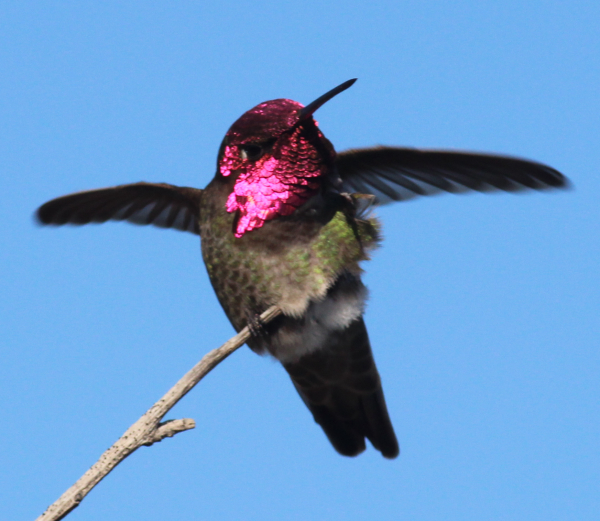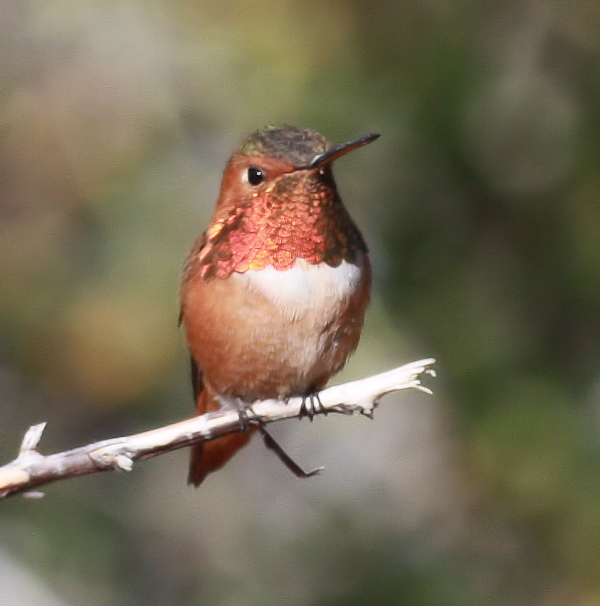

Throughout winter months, birders in California and parts of Arizona enjoy the territorial displays of male Anna’s Hummingbirds.

Southern California birders can find Allen’s Hummingbirds throughout the year, including winter months when they begin nesting activities after the rainy season begins (photos by Paul Konrad).
|
While many of our northern feeding stations are surrounded by snow, birders in California and some areas of southern states as far east as Louisiana continue to enjoy hummingbirds in their yards – attracted by nectar feeders, flower gardens, and water misters – what luck! But some northern birders plan winter getaways to warmer climates where they can enjoy hummingbirds, often species they don’t see in their northern hangouts. If you’re southbound, pack a hummingbird feeder in your suitcase and see what you can attract during your visit to sunbelt hummingbird hotspots.
Anna’s Hummingbirds are present during the winter season along our West Coast states from western Washington to southern California and parts of Arizona. Anna’s share the winter landscape with Allen’s Hummingbirds that winter in the metropolitan areas of Los Angeles and its expansive suburbs and adjacent native lands. Area birders who offer flower gardens and flowering trees along with their sugar-water nectar feeders can be graced with visits by both species, with the possibility of seeing other hummingbird species during migration. Even now, female Anna’s and Allen’s hummers are already nesting, and males are performing impressive flight displays as well as perched territorial displays. In drier areas bordering desert landscapes in SoCal you may find Costa’s Hummingbirds during winter months too.
California Live Cam – If you’re not living in or planning a visit to locations where you can see winter hummingbirds, you can always visit an active hummingbird feeding station online, such as the ultra-busy feeders at a Southern California hotspot that attracts a surprising abundance of Anna’s and Allen’s Hummingbirds at https://www.hummingbirdspot.com/live-cam – and be sure to click the arrow in the center of the photo to get the live view. The Allen’s Hummingbirds show rufous coloration mixed with green, while the mostly green Anna’s have no rufous plumage.
Birders in southern-most Texas appreciate Buff-bellied Hummingbirds throughout the year, and some Buff-bellies can be found at locales through coastal Texas and Louisiana during winter. Arizona is known for its hummingbirds, but during winter Anna’s is the most likely hummingbird you will see in desert and metropolitan areas. Although southeast Arizona is a special hummingbirding destination, the best time to see a variety of species is during late summer and early fall.
A few southern birders are lucky enough to attract a wide-ranging, off-course hummingbird now and then – most often a Rufous Hummingbird. This species is notorious for showing up at a hummingbird feeder beyond the species’ normal range, but Ruby-throats and Anna’s Hummingbirds can also show up beyond their normal winter range, along with other off-course hummers. This fact makes keeping a nectar feeder stocked through fall and winter in sunbelt climes make sense, just in case a wayward hummer swings through your neighborhood. This practice is underlined by the fact that Louisiana birders attract eight different hummingbird species during winter months in a state that normally only attracts one winter species.
Latin American Hummingbirding – Some “snowbirders” even travel beyond our borders to visit hummingbird hotspots in Latin America and the Caribbean. Many do it on their own, staying at a birding lodge famous for attracting hummingbirds to their feeding stations and gardens. But one of the leading birding tour companies – Field Guides – offers birding tours where you can experience 20 to 50 different species of hummingbirds. And to get you in the hummer spirit, they even have an exceptional online slide show that features photos of remarkable hummingbirds photographed during their trips at https://fieldguides.smugmug.com/SHOWS/Hummingbirds-II/i-8kBGfRb
One hummingbirder has taken her interest in hummingbirds to the highest levels: Carol Turek, who has an impressive and informational website, is on a personal mission to photograph every hummingbird species. And they’re not just documentary photos, they are spectacular color photos of some of the most impressive hummingbirds you’ll ever see. On the Hummingbird Spot website at https://www.hummingbirdspot.com/ you will also find literally “everything hummingbirds,” including an impressive variety of hummingbird-related products, from cellphone covers to throw pillows and kitchen aprons featuring Carol’s hummingbird photographs, not to mention photographic artwork, nectar feeders, and lots more.
And if you enjoy watching exotic hummingbirds in action, be sure to review the exciting videos provided on the Hummingbird Spot website at https://www.hummingbirdspot.com/videos and view some of the most spectacular hummers in action, including Snowcaps, Marvelous Spatuletails, Shining Sunbeams, and Rufous-crested Coquettes – Wow! Check out Carol’s trip reports south of the border too!
If you enjoy winter hummingbirds in your yard, you’re considered especially lucky by birders from more northern climes. But we hope this winter primer has enlivened you to consider all the different ways you can enjoy hummingbirds, and if you are excited as you await the return of spring hummers, we hope it inspires you to prepare for when hummingbirds return to your area. Maybe it’s time to shop for a new feeder, or to plan your flower garden and yard enhancements to attract and benefit even more hummers this year. For now, enjoy some of the hummingbird references we provided above, and appreciate there is a hemisphere of hummingbirds beyond your yard to learn more about as you expand your birding interests.
Share your backyard birding experiences and photos at editorstbw2@gmail.com